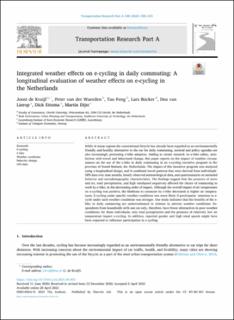| dc.contributor.author | de Kruijf, Joost | |
| dc.contributor.author | van der Waerden, Peter | |
| dc.contributor.author | Tao, Feng | |
| dc.contributor.author | Böcker, Lars | |
| dc.contributor.author | van Lierop, Dea | |
| dc.contributor.author | Ettema, Dick | |
| dc.contributor.author | Dijst, Martin | |
| dc.coverage.spatial | Netherlands | en_US |
| dc.date.accessioned | 2021-07-12T10:27:30Z | |
| dc.date.available | 2021-07-12T10:27:30Z | |
| dc.date.created | 2021-05-27T10:49:37Z | |
| dc.date.issued | 2021-04-20 | |
| dc.identifier.citation | Transportation Research Part A: Policy and Practice. 2021, 148, 305-315. | en_US |
| dc.identifier.issn | 0965-8564 | |
| dc.identifier.uri | https://hdl.handle.net/11250/2764148 | |
| dc.description.abstract | While in many regions the conventional bicycle has already been regarded as an environmentally friendly and healthy alternative to the car for daily commuting, societal and policy agendas are also increasingly promoting e-bike adoption. Adding to recent research on e-bike safety, satisfaction with travel and behavioral change, this paper reports on the impact of weather circumstances on the use of the e-bike in daily commuting in an e-cycling incentive program in the province of Noord-Brabant, the Netherlands. The impact of this incentive program was analyzed using a longitudinal design, and it combined travel patterns that were derived from individuals’ GPS data over nine months, hourly observed meteorological data, and questionnaires on intended behavior and sociodemographic characteristics. The findings suggest that the presence of snow and ice, total precipitation, and high windspeed negatively affected the choice of commuting to work by e-bike, in this decreasing order of impact. Although the overall impact of air temperature on e-cycling was positive, the likeliness to commute by e-bike decreased at higher air temperatures. E-cycling under specific weather conditions was more likely if participants’ intention to e-cycle under such weather conditions was stronger. Our study indicates that the benefits of the e-bike in daily commuting are underestimated in relation to adverse weather conditions. Respondents from households with one car only, therefore, have fewer alternatives in poor weather conditions: for these individuals, only total precipitation and the presence of relatively low air temperature impact e-cycling. In addition, reported gender and high wind speeds might have been expected to influence participation in e-cycling. | en_US |
| dc.language.iso | eng | en_US |
| dc.publisher | Elsevier | en_US |
| dc.rights | Attribution-NonCommercial-NoDerivatives 4.0 Internasjonal | * |
| dc.rights.uri | http://creativecommons.org/licenses/by-nc-nd/4.0/deed.no | * |
| dc.title | Integrated weather effects on e-cycling in daily commuting: A longitudinal evaluation of weather effects on e-cycling in the Netherlands | en_US |
| dc.type | Peer reviewed | en_US |
| dc.type | Journal article | en_US |
| dc.rights.holder | © 2021 The Authors | en_US |
| dc.description.version | publishedVersion | en_US |
| cristin.ispublished | true | |
| cristin.fulltext | original | |
| cristin.qualitycode | 2 | |
| dc.identifier.doi | 10.1016/j.tra.2021.04.003 | |
| dc.identifier.cristin | 1912175 | |
| dc.source.journal | Transportation Research Part A: Policy and Practice | en_US |
| dc.source.volume | 148 | en_US |
| dc.source.pagenumber | 305-315 | en_US |

